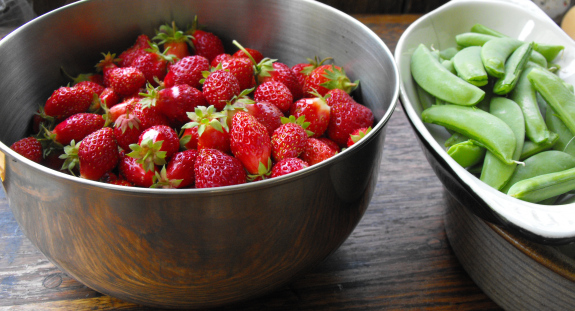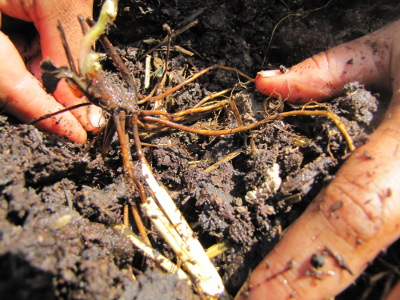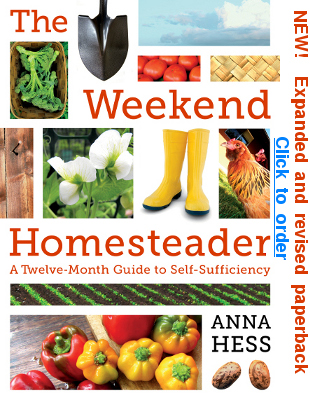
Choosing and planting strawberries

Be forewarned --- once
you taste a homegrown strawberry, you'll never
be able to eat another berry from the grocery store. Even ripe
fruits plucked fresh from a you-pick operation don't hold a candle to
the explosion of flavor inside a strawberry grown in the humus-rich,
no-till garden. Luckily, strawberries are pretty simple to grow
in your backyard, so you'll be able to feed your new addiction.
Your first step when planting
strawberries is variety selection.
Although everbearing strawberries look good on paper, I find
June bearers to be less work with higher returns, so I recommend the
beginning homesteader start there. Even if you stick with
June bearers, you can count on a full month of strawberries if you
plant early, midseason, and late varieties (and be aware that
"June bearers" actually fruit in April and May in the south and middle
of the country --- the name simply refers to the single annual
crop.) Your extension
service is the best source for
recommendations of varieties that do well in your area.
Strawberries can be planted in the early spring or in the fall. I
tend to plant in the fall when expanding my own strawberry patch but in
the spring when buying in fresh plants --- that way, I don't lose my
expensive new stock to drought.
 You'll get the most value for
your money if you buy bare-rooted strawberries in sets of 25 from an
online nursery. The strawberries will come with few or no leaves
and will look
quite dead, but when planted with the roots spread out just below the
soil surface and the growing crown peeking up slightly above the
ground,
new leaves will soon appear.
You'll get the most value for
your money if you buy bare-rooted strawberries in sets of 25 from an
online nursery. The strawberries will come with few or no leaves
and will look
quite dead, but when planted with the roots spread out just below the
soil surface and the growing crown peeking up slightly above the
ground,
new leaves will soon appear.
There are several different methods of growing strawberries, and your
initial plant spacing will depend on which technique you plan to
follow. I put in a bit more work to get tastier fruits, spacing
my plants 12 inches apart and removing all of the runners --- this is
called the hill system. If you're more of a laissez faire
gardener, you might prefer the matted row system, in which plants are
spaced much further apart and allowed to fill up the gaps with
runners. The benefit of the matted row system is that it's less
work in year one and you don't have to buy as many plants; the downside
is that you'll spend more time next year picking lots of small fruits
that often aren't quite as tasty as the fewer big fruits you get from
the hill system.
 No matter which spacing method you choose, be aware that strawberries
can handle a little bit more shade then most vegetables but will give
you the sweetest fruits in full sun. Strawberries can also become
quickly overwhelmed by weeds, so mulch them
carefully and repeatedly and hand weed as necessary. If you're
planting into weedy ground, you might choose to lay down a kill mulch
(see Weekend
Homesteader: May) and plant your strawberries into small
holes cut in the cardboard.
No matter which spacing method you choose, be aware that strawberries
can handle a little bit more shade then most vegetables but will give
you the sweetest fruits in full sun. Strawberries can also become
quickly overwhelmed by weeds, so mulch them
carefully and repeatedly and hand weed as necessary. If you're
planting into weedy ground, you might choose to lay down a kill mulch
(see Weekend
Homesteader: May) and plant your strawberries into small
holes cut in the cardboard.
This
week's lunchtime series is exerpted from Weekend
Homesteader: February,
which is available for 99 cents from Amazon's kindle store. The
ebook
also includes a primer on choosing and caring for a backyard flock of
chickens, information on buying in bulk, and tips for creating your own
apprenticeship. If you enjoy the book, please consider leaving me
a
review.
| This post is part of our Easy Berries lunchtime series.
Read all of the entries: |
Want more in-depth information? Browse through our books.
Or explore more posts by date or by subject.
About us: Anna Hess and Mark Hamilton spent over a decade living self-sufficiently in the mountains of Virginia before moving north to start over from scratch in the foothills of Ohio. They've experimented with permaculture, no-till gardening, trailersteading, home-based microbusinesses and much more, writing about their adventures in both blogs and books.
Want to be notified when new comments are posted on this page? Click on the RSS button after you add a comment to subscribe to the comment feed, or simply check the box beside "email replies to me" while writing your comment.

Anna
How many years will a strawberry patch produce using the hill system before you have to replant with new plants?